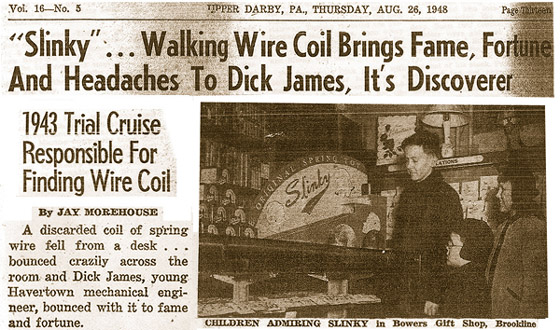The Slinky was Originally Intended to be Used as a Tension Spring in a Battleship Engine Horsepower Meter
 Today I found the Slinky was originally intended to be used as a tension spring in a battleship engine horsepower meter.
Today I found the Slinky was originally intended to be used as a tension spring in a battleship engine horsepower meter.
In 1943, Richard James, a marine engineer in a Philadelphia shipyard, was working at his desk, developing a special meter designed to monitor the horsepower output on naval battleships. This meter required the use of special springs in order to stabilize the instrument in rough seas. At a certain point, James accidentally knocked a length of one of the springs he was working with off his desk. To his amazement, the spring fell from its position on the desk, then “walked” from that point to a stack of books, and eventually on to the floor where it coiled back up.
Richard rushed home and told his wife about what happened and said, “I think if I got the right property of steel and the right tension, I could make it walk.”. He went on to tell her he thought he could make a child’s toy out of it.
After some time, Richard made a few prototypes, which he let children in his neighborhood play with in order to gauge the response, which ended up being overwhelmingly positive. His wife, Betty, then searched for a name for this new toy. After searching through the dictionary for hours, she finally settled on “Slinky”, meaning “sinuous and slender” and had previously been used mainly as an adjective to describe women or clothing.
With a $500 loan to pay a company to manufacture a small quantity of Slinkies, in 1945, Richard and Betty made an attempt to sell the toy in a retail outlet store in Philadelphia. The retail store agreed to put 400 Slinkies on display for the upcoming Christmas shoppers. After a few days and no sales, Richard began to fear the worst. He decided to go down to the store and display what the toy could do. His wife Betty agreed to meet up with him later that night. When she arrived, she saw a line of customers purchasing every last slinky. All 400 Slinkies sold in 90 minutes.
And the rest, as they say is history…
Bonus Facts
- In 1960, Richard James left his struggling company, which was deeply in debt, and moved to Bolivia where he became a missionary. When Betty refused to go with him, he told her she could have the company and he didn’t care what she did with it. Betty then took over the company and proved to be a much better business person than her ex-husband. The company expanded greatly under her leadership and to date has sold over 300 million Slinkies.
- For her contributions in making the Slinky one of the all time best selling toys in the world, Betty James was inducted into the Toy Industry Hall of Fame in 2001. She died in 2008, at the age of 90. Her ex-husband, Richard James, died just 14 years after moving to Bolivia, in 1974.
- Around 80 feet of wire was used in the original slinky design.
- In 1945, the original Slinky toy sold for $1.00. Today, the same Slinky sells for about $1.99.
- Other than toys, Slinkies have been used in pecan picking, drapery holders, antennas, light fixtures, window decorations, gutter protectors, bird house protectors, therapeutic devices, wave motion coils, table decorations, and mail holders, among other things. Notable among these were U.S. troops in Vietnam using the Slinky as mobile radio antennas and NASA later using Slinkies in certain zero-gravity experiments.
- 50,000 tons of wire (around 3,030,000 miles worth) has been used in making the slinky since 1945 to present. That’s about enough wire to go around the Earth 121 times at the equator.
Expand for References:
| Share the Knowledge! |
|






Nice article thanks
I read that it was his wife not him who pushed for it to be a toy!!
Slinky reminds me of some people. You don’t know why, you just know you want to push them down the stairs…
I thought Richard.T.James made the slinky by accident.